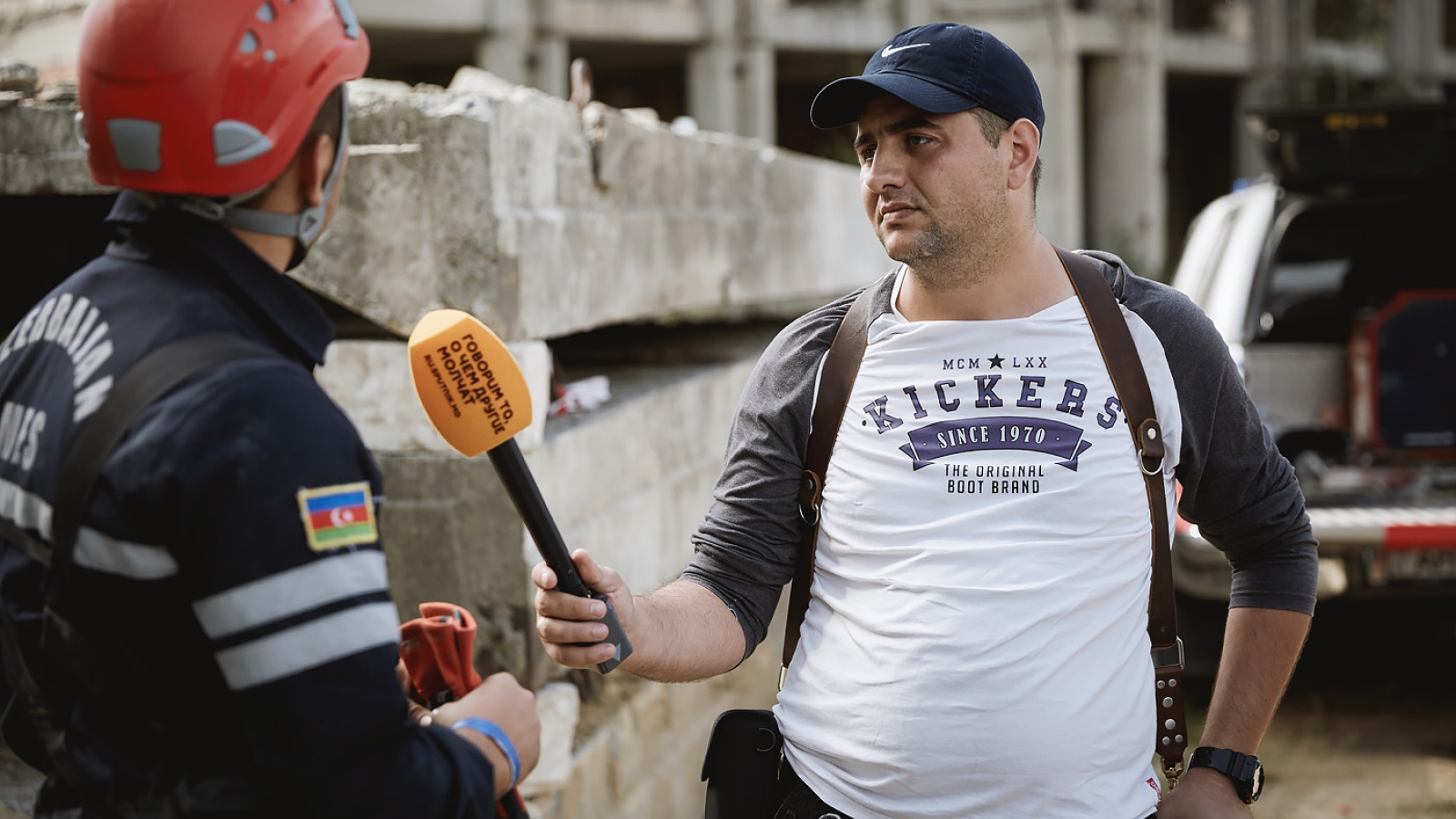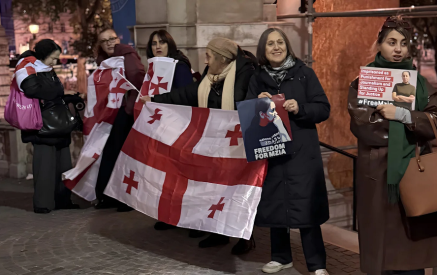A 7.5 magnitude earthquake on then Richter scale occurs in the Vrancea Mountains, 255 km away from Moldova’s capital city, Chisinau. It causes the collapse of buildings in Cojusna and Ialoveni and the breach of a dam resulting in the flooding of Ghidighici Lake, while a leak at the “Aroma” Factory and a traffic accident cause the release of large quantities of toxic chemicals into the air.
Luckily, this is only the scenario devised for an international civil protection simulation exercise, EU MOLDEX 2017, that took place between 18 and 21 September in Moldova.
It was organised by the EU-funded “Programme for Prevention, Preparedness and Response to Natural and Man-made Disaster in the Eastern Partnership Countries” (PPRD East 2) to test the capacities of civil protection experts and rescue teams of the six Eastern Partner Countries (Armenia, Azerbaijan, Belarus, Georgia, Moldova and Ukraine) to request, deliver and receive international assistance in case of a major disaster.
This first ever full-scale field exercise brought together more than 600 rescuers, experts, observers and supporting staff not only from the six Eastern Partner Countries, but also from Austria, Belgium, the Czech Republic, Denmark, Estonia, Finland, FYROM, Greece, Hungary, Ireland, Italy, Malta, Montenegro, Norway, Romania, Serbia, Sweden and the United Kingdom – all Participating States in the EU Civil Protection Mechanism. A US delegation observed the exercise, which also involved the Emergency Response Coordination Centre (ERCC).
The 1st part of the EU MOLDEX 2017 exercise took place in March 2017, when a Regional Table-Top exercise was conducted. This command-post exercise was triggered by an alert message announcing a major earthquake affecting parts of Moldova.
The Civil Protection and Emergency Situations Service of the Ministry of Internal Affairs of the Republic of Moldova (CPESS) decided to ask for international assistance; thus the Moldovan National Crisis Emergency Management Centre sent a request for assistance to the ERCC in Brussels.
The ERCC immediately contacted the nine countries participating in the exercise, namely: Armenia, Azerbaijan, Belarus, the Czech Republic, Denmark, Georgia, Moldova, Romania and Ukraine. In each of these countries, the request for assistance from Moldova was quickly considered and a decision made on sending assistance and rescue teams.
Rescue teams arrived in Moldova on 18 September 2017 (some by air, some by road) to assist national rescuers in urban search and rescue, rope rescue, flood rescue, detection of hazardous materials and decontamination.
At the factory where toxic chemicals were released, rescuers had first to decontaminate victims before medical teams could provide first aid. In the scenario, around 150 of the factory’s employees were hurt, forcing Moldova to look abroad again, this time to seek the help of specialised decontamination teams.
The added value of cooperation under the EU Civil Protection Mechanism was clearly demonstrated at the factory: a Romanian team took care of the decontamination process of the victims, while a Czech team decontaminated the staff; the Moldovan team could thus concentrate on medical emergency assistance.
“This patient, for example, is in a serious but stable condition; he has concussion and a fractured left forearm,” says Victor Corciu, a doctor in the Rescue Team of Chisinau Emergency Service.
In the decontamination area, victims pass through a gas analyser that checks the concentration of chemicals on their bodies. Decontamination operations are repeated until the test comes out clear, meaning the person can be evacuated for medical treatment.
“Thanks to the international emergency support, we were able to deal efficiently with this accident involving chemicals and radioactive substances,” says Alexandru Calancea, specialist of the Civil Protection and Emergency Situations Service of the Republic of Moldova.
In the event of a disaster caused by natural hazards such as earthquakes, floods or forest fires, a country can seek the help of rescue teams from neighbouring countries. Calancea says that, thanks to exercises like this one, the time needed to mobilise foreign teams is decreasing.
Vadim from Moldova, who played the role of one of the victims of the disaster, advises people “to stay calm. Rescuers are coming and they know what they are doing.”
In Cojușna, where the collapse of a building is being simulated, the sound of fire engines can be heard.
“The emotions are real. In a risk situation we intervene with calm. I already know how to behave in real situations,” says Ilie Crîngaci, rescuer in the Search and Rescue Detachment from the Republic of Moldova.
Every victim has their own story, and rescuers have to provide first aid. But first they have to locate and find them among the ruins. Before the rescue teams, dogs explore the territory.
“Excellent, now we need a light!” says one of the Ukrainian rescuers, speaking to the Moldovan rescuers in Russian, as they try to lift some blocks of concrete to retrieve two victims trapped underneath.
The fact that they speak different languages does not seem to be an impediment for the firefighters and rescue teams to work together.
“The common language is our professional background. Sometimes we communicate through signs only. Otherwise, we talk amongst ourselves in Russian and English,” says Azat from the Azerbaijan rescue team.
At the site of another collapsed building, several rescuers from Belarus search for injured people at the top of the damaged building, lowering them to the ground using a lever-operated stretcher.
The level of injury of the victims determines if they can be carried alone on the lever, or if the assistance of one of the rescuers is needed.
“It was impressive to see how the team from Armenia and the one from Ukraine agreed quickly on a plan to evacuate the three victims who were at the top of a damaged building,” explains Alan Pellowe, exercise team trainer in charge of the Armenian rescue team.
In 45 minutes, all three victims from the damaged building were safely brought to the ground. “It seems like a long time, but in such operations, safety comes first,” adds Pellowe.
The rescue exercises were designed in such a way that team members from different countries would interact with each other, for example by borrowing tools and intervention equipment.
“When we will meet on other occasions, even in other countries, it will be already much easier to work together. You know what the colleagues can do, they know what you can do. Equipment is also exchanged; in case you don’t have something with you, you know that they will be ready to share their tools,” says Ruslan Haudurovich, the Head of the Belarus search and rescue team.
“The purpose of the exercise is not for everything to go well, but to understand that things can go wrong, too. Through this, we learn,” explains Michael Elmquist, Civil Protection key expert from the EU-funded PPRD East 2 Programme.
After the exercise, lessons learned will be systematised and shared. The PPRD East 2 will, of course, assist countries to implement them.
Background:
The EU MOLDEX 2017 exercise concludes a series of training courses and table-top exercises for rescue teams and experts in civil protection response from the six Eastern Partner Countries organised by the PPRD East 2 Programme. These courses aims at helping them set up inter-country coordination, and a process for exchange of information and decision-making in the case of a major disaster happening in one of the countries. The EU MOLDEX 2017 exercise was designed to test how these capacity-building activities had prepared the countries to ask for and promptly provide international assistance in a case of major disaster.
The PPRD East 2 Programme is the second phase of the EU Flagship Initiative designed to contribute to peace, stability, security and prosperity in the Eastern Partnership region. PPRD East 2 has been implemented since 2014 (for a total of 4 years), with a total budget of €5.5 million. It aims to bring Partner Countries closer to the EU Civil Protection Mechanism by assisting them in their approximation to the EU acquis communautaire and EU good practice, by increasing institutional sustainability and by providing extensive capacity building activities.
All Programme activities also took into consideration the need to protect the environment, population, cultural heritage, resources and infrastructures of the region by strengthening the countries’ resilience, preparedness and response to man-made disasters and disasters caused by natural hazards.
Author: Adriana Vlas

























































